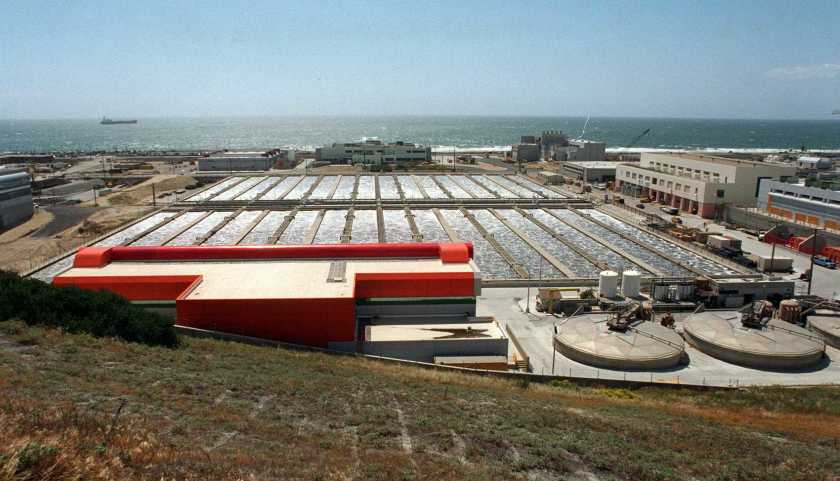As noxious fumes sicken residents, anger grows about Hyperion plant sewage discharge

On a jog in her El Segundo neighborhood, Corrie Zupo's head hurt and her eyes watered.
She blamed the symptoms on noxious fumes from the nearby Hyperion Water Reclamation Plant, which is undergoing at least a month of repairs after discharging 17 million gallons of raw sewage into the ocean on July 11.
Other residents have complained of rashes, nausea and burning eyes.
On Thursday, the Los Angeles Sanitation and Environment Department, which runs the plant, announced that it would reimburse El Segundo residents for air conditioners if they stay in their homes, or hotel vouchers if they would rather leave.
For Zupo and others, including El Segundo city officials and L.A. City Controller Ron Galperin, that's not enough.
They want answers on why the plant was so overwhelmed by debris that it had to release a massive amount of sewage to avoid completely shutting down.
They want to know why sanitation officials took so long to announce the discharge, why there was a delay in offering financial assistance to residents, and what the long-term effects on beaches and marine life will be.
Zupo, co-chair of the El Segundo Environment Committee, organized a protest Thursday outside the plant.
“We totally understand accidents happen, natural disasters happen,” she said. “What we're asking for, though, is accountability [so] that in the future, this doesn't happen.”
Galperin called the sewage release "an environmental disaster and imminent threat to the health and safety of millions of residents."
In a letter to Barbara Romero, director and general manager of L.A. Sanitation and Environment, he questioned why debris, including wood chips, concrete, paper and grease, could clog the plant's filters to such an extent that the drastic measure was necessary.
"The fact that such a seemingly mundane sequence of events could lead to 17 million gallons of untreated sewage being released raises concerns about LASAN's ability to prevent future emergencies," he wrote.
On its website, the sanitation department this week "sincerely apologized" for any inconvenience and said workers put up a "valiant struggle."
"Their heroic efforts averted a much larger catastrophe and limited the discharge of untreated wastewater to 17 million gallons, which is a small fraction of the 260 million gallons per day that could have polluted Santa Monica Bay for days on end," the statement read.
The Hyperion plant, just off Dockweiler State Beach in Playa Del Rey, has been operating since 1894 and is L.A.'s oldest and largest wastewater treatment facility.
That Sunday afternoon, as the plant's filters became clogged with "overwhelming quantities of debris," officials decided to empty raw sewage a mile offshore instead of through the normal system five miles away, the sanitation department said on its website.
That prevented "the plant from going completely offline and discharging much more untreated wastewater," the department said.
The plant itself was severely flooded, and equipment that treats and cleans wastewater was damaged. The plant is operating on backup systems; repairs will take a month or more.
Because of the damage, a fuel that is a byproduct of the wastewater treatment is being made in smaller amounts and must be destroyed, which can cause odors, noise, smoke and flames.
"Hyperion is taking all measures to mitigate impacts (odors, noise, etc.) to the community during the cleanup and repairs to fully restore functionality of the plant," the department said.
After the sewage discharge, officials from the L.A. County Department of Public Health did not immediately notify the public that the beaches were unsafe, putting swimmers at risk.
About 24 hours elapsed before county officials tweeted a beach closure advisory at 5:30 p.m. that Monday, urging residents to avoid swimming at Dockweiler and El Segundo beaches.
Lifeguards found out about the closure a few hours earlier, about noon, after seeing a county worker posting a sign on a lifeguard tower. They then began warning beachgoers to stay out of the water.
On July 14, county health officials reopened areas of both beaches.
El Segundo residents in the area bounded by Imperial Highway, Pacific Coast Highway, El Segundo Boulevard and Vista del Mar are eligible for the air conditioning or hotel reimbursements.
El Segundo City Manager Scott Mitnick had been pushing L.A. officials for the reimbursements, which were not announced until more than a week after the sewage discharge.
In a letter to Hyperion's executive plant manager, Timeyin Dafeta, Mitnick cited "recurring impacts" such as construction noise, smoke, flaring and odors.
He requested that L.A. officials "do a better job informing our community as to what is going on and when this nightmare will end."
This story originally appeared in Los Angeles Times.

